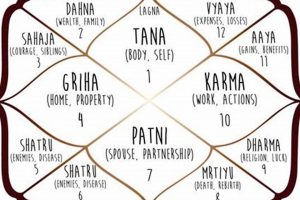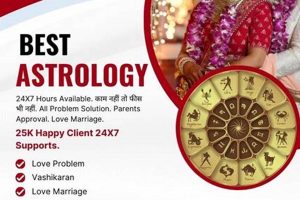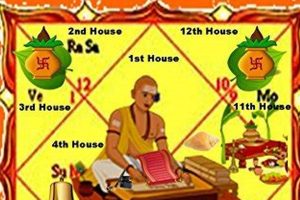Compatibility analysis based on Vedic astrological principles often involves examining birth charts to assess the potential for a deep, soul-level connection between individuals. This process may leverage specific calculations pertaining to planetary positions and nakshatras (lunar mansions) at the time of birth. For instance, analyzing the synastry chart, which overlays two individual birth charts, can reveal potential areas of harmony and discord.
This practice aims to provide insights into relationship dynamics, karmic connections, and the potential for a fulfilling partnership. Rooted in ancient Vedic traditions, this form of compatibility assessment offers a unique perspective on interpersonal relationships beyond superficial attraction, seeking to understand the deeper energetic connections between individuals. This understanding can be valuable for individuals seeking self-awareness in relationships and exploring the potential for long-term compatibility.
This exploration delves further into the specific methodologies used in Vedic astrology for relationship analysis, covering topics such as planetary influences, nakshatra compatibility, and the interpretation of synastry charts. It also addresses common misconceptions and limitations associated with this practice, offering a balanced perspective on its application.
These tips offer guidance for approaching astrologically-based relationship analysis with clarity and discernment.
Tip 1: Consult Qualified Practitioners: Seeking guidance from experienced Vedic astrologers is crucial for accurate birth chart interpretations and nuanced relationship analysis. Expertise is essential for navigating the complexities of astrological principles.
Tip 2: Prioritize Self-Awareness: Astrology serves as a tool for self-reflection, not a deterministic prediction. Use insights gained to understand personal patterns and tendencies within relationships, rather than relying solely on external validation.
Tip 3: Consider the Whole Chart: Compatibility assessments involve more than just isolated factors. A comprehensive analysis considers the interplay of all planetary positions and aspects within both birth charts.
Tip 4: Avoid Oversimplification: Reduce the temptation to view compatibility as a simple “yes” or “no” outcome. Relationship dynamics are complex, and astrological analysis offers layers of understanding, not definitive pronouncements.
Tip 5: Focus on Growth and Understanding: Astrological insights can facilitate personal and relational growth. Use the information gained to foster greater understanding, communication, and empathy within relationships.
Tip 6: Respect Individual Agency: Astrology does not dictate relationship outcomes. Individual choices and actions remain paramount in shaping the course of any relationship.
By integrating these tips, individuals can approach compatibility analysis through Vedic astrology with a balanced and informed perspective, using it as a tool for self-discovery and relationship enhancement.
This understanding forms a basis for a concluding discussion on the role of Vedic astrology in fostering meaningful connections.
1. Birth Chart Comparison
Birth chart comparison serves as a cornerstone of Vedic astrology’s approach to relationship analysis, offering a framework for understanding the dynamics between individuals. By comparing two birth charts, astrologers seek to identify points of synergy and potential conflict, providing a nuanced perspective on compatibility beyond superficial attraction. This comparative analysis is integral to the broader concept of a “Vedic astrology soulmate calculator,” even if that term oversimplifies a complex process.
- Planetary Aspects:
Analyzing the angular relationships between planets in two birth charts reveals significant insights into interpersonal dynamics. For example, a conjunction, where planets align in the same sign, can signify a strong connection, while a square aspect, a 90-degree angle, might indicate tension or friction. These aspects offer clues about communication styles, emotional compatibility, and potential challenges within a relationship.
- House Overlays:
Examining how the planets of one chart fall into the houses of another provides insight into how each individual influences different areas of the other’s life. For instance, if one person’s Venus (planet of love) falls in the other person’s 7th house (house of partnership), it suggests a strong emphasis on affection and harmony in the relationship. This analysis illuminates how each person contributes to the partnership and what areas might be emphasized.
- Nakshatra Harmony:
Comparing the nakshatras (lunar mansions) in which key planets are placed offers insights into the emotional and spiritual compatibility between individuals. Certain nakshatra combinations are considered more harmonious than others, reflecting a deeper level of connection beyond planetary aspects. This analysis reveals the subtle energetic interplay between individuals.
- Karmic Connections:
Birth chart comparison can also unveil potential karmic links between individuals. Indicators such as the position of the South Node of the Moon can suggest past-life connections and the lessons to be learned in the current relationship. This analysis provides context for recurring patterns and the potential for growth and healing within the partnership.
These interwoven facets of birth chart comparison contribute to a comprehensive understanding of relationship dynamics within the framework of Vedic astrology. By considering these elements, individuals can gain a deeper understanding of their connections with others, moving beyond simplistic notions of “soulmates” toward a more nuanced appreciation for the complexities of human relationships. This detailed analysis allows for a personalized interpretation rather than a generalized “calculator” approach.
2. Planetary Positions
Planetary positions at the time of birth are fundamental to Vedic astrological compatibility analysis. These positions form the basis of an individual’s birth chart, which acts as a cosmic blueprint, mapping planetary influences on personality, tendencies, and karmic predispositions. Within the context of relationship analysis, comparing planetary positions between two individuals reveals potential areas of harmony, discord, and growth. The positions of key planets like Venus (representing love and attraction), Mars (representing passion and drive), and the Moon (representing emotions and intuition) are particularly significant in assessing relationship dynamics. For instance, if Venus in one person’s chart forms a favorable aspect with Mars in another person’s chart, it may indicate a strong romantic connection and physical attraction. Conversely, if Saturn (representing limitations and challenges) aspects these planets negatively, it suggests potential difficulties or delays in the relationship.
The interaction of these planetary positions provides a nuanced understanding beyond simplified compatibility scores. For example, while a certain planetary combination might generally be considered challenging, its specific manifestation depends on the signs, houses, and other planetary influences within each individual’s chart. This complexity highlights the importance of consulting experienced Vedic astrologers for personalized interpretations. Understanding the influence of specific planetary positions offers valuable insights into communication styles, emotional needs, and potential conflict areas within a relationship. It allows individuals to navigate their relationships with greater awareness and address potential challenges proactively, fostering healthier dynamics.
Planetary positions offer a crucial lens through which to understand relationship dynamics within the framework of Vedic astrology. While the term “Vedic astrology soulmate calculator” might suggest a simplistic approach, the reality is far more nuanced. Accurate interpretation requires a comprehensive understanding of the interplay between planetary positions, signs, houses, and nakshatras. This deeper analysis empowers individuals to move beyond generalized predictions and engage with their relationships with greater awareness and understanding, fostering more fulfilling connections. It promotes a proactive approach to relationship building rather than relying on deterministic outcomes.
3. Nakshatra Compatibility
Nakshatra compatibility plays a crucial role within the broader context of Vedic astrological relationship analysis, often referred to as a “soulmate calculator.” Nakshatras, also known as lunar mansions, are 27 segments of the zodiac, each imbued with specific qualities and symbolism. Analyzing the nakshatras of two individuals, particularly those of the Moon, provides insights into their emotional, mental, and spiritual compatibility. This compatibility assessment considers factors such as the distance between nakshatras, their inherent characteristics, and their governing deities. Certain nakshatra combinations are considered inherently harmonious, promoting natural understanding and synergy, while others may present challenges that require conscious effort to navigate. For instance, if two individuals have their Moon in nakshatras ruled by compatible deities, it can foster a sense of shared values and spiritual connection. Conversely, nakshatras in conflicting positions may indicate potential communication barriers or emotional discord.
The practical significance of nakshatra compatibility lies in its ability to provide a deeper understanding of the subtle energetic dynamics within a relationship. While planetary positions offer a general overview of compatibility, nakshatras delve into the nuances of emotional and spiritual connection. This understanding can be invaluable in navigating the complexities of interpersonal relationships. For example, recognizing a potential nakshatra-based communication challenge allows individuals to address it proactively, fostering greater understanding and empathy. Furthermore, nakshatra compatibility can shed light on the karmic connections between individuals, offering insights into past-life influences on the present relationship. This understanding allows individuals to approach their relationships with greater awareness and address potential karmic patterns constructively.
Nakshatra compatibility adds a crucial layer of depth to Vedic astrological relationship analysis. It moves beyond simplistic notions of “soulmates” and provides a framework for understanding the energetic interplay between individuals. While the term “soulmate calculator” may be a convenient shorthand, the actual process is a complex and nuanced exploration of astrological factors. Understanding nakshatra compatibility empowers individuals to navigate their relationships with greater awareness, fostering more fulfilling and harmonious connections by addressing potential challenges proactively and appreciating the unique energetic dynamics at play.
4. Synastry Chart Analysis
Synastry chart analysis forms a cornerstone of what is popularly termed a “Vedic astrology soulmate calculator.” This technique overlays the birth charts of two individuals, creating a composite map that reveals the energetic interplay between their respective planetary positions. This analysis serves as a crucial tool for understanding relationship dynamics, potential challenges, and areas of compatibility. Synastry illuminates how each individual’s planetary energies interact with the other’s, offering insights into communication styles, emotional responses, and karmic connections. For example, if one person’s Venus (planet of love) conjuncts another person’s Mars (planet of action), it can signify a passionate and dynamic connection. However, this same combination could also lead to conflicts if the individuals involved have incompatible temperaments. This analysis provides a nuanced understanding beyond simplistic “compatible” or “incompatible” pronouncements. Consider a hypothetical case where one person’s Saturn (planet of restriction) aspects another person’s Moon (planet of emotions). This could manifest as emotional guardedness or a sense of responsibility within the relationship. Synastry provides a framework for understanding these dynamics, rather than offering deterministic predictions.
Synastry charts move beyond isolated planetary comparisons to encompass a holistic view of the relationship. Analyzing house overlays, where one person’s planets fall within the houses of the other’s chart, reveals how each individual influences different spheres of the other’s life. For example, someone’s Sun (representing core identity) falling in another person’s 4th house (representing home and family) might suggest a strong domestic connection. Understanding these overlays provides valuable context for relationship dynamics. This nuanced perspective differentiates synastry from simplified compatibility assessments. Consider a scenario where one person’s Mars falls in another person’s 12th house (representing hidden matters and spirituality). This might signify an unspoken tension or a karmic connection influencing the relationship subconsciously. Synastry offers tools to explore these complexities, fostering a deeper understanding of the dynamics at play. The practical application lies in using these insights to address potential challenges proactively and cultivate greater harmony.
Synastry chart analysis offers a crucial tool for understanding the intricacies of interpersonal relationships within the framework of Vedic astrology. While the concept of a “soulmate calculator” provides a catchy entry point, the reality is far more nuanced. Synastry provides a comprehensive map of relationship dynamics, enabling individuals to navigate their connections with greater awareness. The analysis offers insights into potential challenges and strengths, empowering individuals to cultivate healthier and more fulfilling relationships. While synastry doesn’t offer definitive predictions, it serves as a powerful tool for self-awareness and relational growth, encouraging proactive engagement with relationship dynamics.
5. Karmic Connections
Karmic connections, a central tenet within Vedic astrology, play a significant role in what is sometimes referred to as a “vedic astrology soulmate calculator.” This concept posits that past-life interactions influence present relationships, shaping dynamics and contributing to a sense of familiarity or discord. Vedic astrology analyzes planetary positions, particularly the lunar nodes (Rahu and Ketu), to understand these karmic influences. The South Node (Ketu) is believed to represent past-life experiences and unresolved karmas, while the North Node (Rahu) points towards the direction of soul growth in the current life. When these nodes interact significantly with personal planets in synastry charts (comparison of two birth charts), they can indicate a strong karmic connection. This connection might manifest as an immediate sense of recognition, unexplained attraction, or recurring patterns within the relationship. For example, a challenging aspect between one person’s Ketu and another’s Venus might suggest unresolved emotional issues from a past life affecting the current relationship’s love dynamic.
The significance of understanding karmic connections lies in the potential for growth and healing. Recognizing karmic patterns allows individuals to address recurring issues and break free from destructive cycles. Consider a scenario where two individuals repeatedly encounter similar conflicts in their relationship. Analysis of their synastry chart, revealing a strong karmic connection, can illuminate the root cause of these conflicts, perhaps stemming from past-life interactions. This awareness empowers them to work consciously on these issues, transforming challenges into opportunities for growth. Another example might involve a couple experiencing a deep, inexplicable connection. Karmic analysis might reveal a past-life bond, explaining this profound sense of familiarity. This understanding fosters appreciation for the depth of their connection and motivates them to nurture the relationship consciously. The practical application of this knowledge is not about finding a preordained “soulmate,” but rather gaining self-awareness and using these insights to navigate relationships more effectively.
Karmic connections within Vedic astrology provide valuable context for understanding relationship dynamics. While the term “soulmate calculator” offers a simplified perspective, the reality is far more nuanced. Karmic analysis doesn’t dictate outcomes but provides a framework for understanding the underlying energetic patterns influencing relationships. This understanding empowers individuals to navigate their connections with greater awareness, transforming challenges into opportunities for growth and fostering more meaningful, conscious relationships. By recognizing karmic influences, individuals can move beyond reactive patterns and engage in their relationships with intention and purpose, facilitating both individual and relational evolution.
Frequently Asked Questions about Vedic Astrological Compatibility
This section addresses common inquiries regarding the application of Vedic astrology in assessing relationship compatibility.
Question 1: Does Vedic astrology guarantee finding a “soulmate”?
Vedic astrology does not guarantee finding a predetermined “soulmate.” It offers insights into relationship dynamics and potential, but individual choices and actions remain paramount. It serves as a tool for understanding, not a predictor of destiny.
Question 2: How accurate are Vedic astrological compatibility assessments?
Accuracy depends on the expertise of the astrologer and the accuracy of birth chart information. Interpretations are nuanced and require considering the entire chart, not just isolated factors. It’s essential to consult qualified practitioners for personalized assessments.
Question 3: Can Vedic astrology predict relationship outcomes?
Vedic astrology does not predict definitive outcomes. It provides a framework for understanding potential challenges and strengths within a relationship. Individual agency and choices ultimately shape the course of any relationship.
Question 4: What is the role of free will in relationships according to Vedic astrology?
Free will plays a crucial role. While astrological influences provide a backdrop, individuals retain the agency to make choices and navigate their relationships consciously. Astrology offers insights, not dictates.
Question 5: Is Vedic astrological compatibility limited to romantic relationships?
Vedic astrology can assess compatibility for various relationships, including familial, business, and friendships. The principles remain consistent, but the focus shifts depending on the nature of the relationship.
Question 6: How can Vedic astrological insights improve relationships?
Vedic astrology empowers individuals to understand themselves and their partners better. This understanding fosters empathy, improves communication, and facilitates navigating challenges more constructively, leading to more harmonious relationships.
Vedic astrological compatibility analysis offers valuable insights into relationship dynamics. It empowers individuals to engage with their relationships consciously, fostering growth and understanding. However, it is crucial to approach this practice with discernment and avoid deterministic interpretations. Consulting qualified practitioners and prioritizing self-awareness are essential for utilizing these insights effectively.
This concludes the frequently asked questions section. The following section explores case studies illustrating practical applications of Vedic astrology in relationship analysis.
Conclusion
Exploration of compatibility through Vedic astrological principles reveals a nuanced approach to relationship analysis. Examining birth charts, planetary positions, nakshatras, and synastry charts provides a framework for understanding potential strengths, challenges, and karmic influences within interpersonal dynamics. While the term “Vedic astrology soulmate calculator” offers a simplified entry point, the practice itself involves a complex interplay of factors requiring in-depth interpretation.
This exploration encourages a shift from deterministic interpretations of compatibility towards utilizing Vedic astrology as a tool for self-awareness and relational growth. By understanding the energetic dynamics at play, individuals can navigate their connections with greater consciousness, fostering more fulfilling and harmonious relationships. Further research and exploration within this field can contribute to a deeper understanding of the intricate interplay between cosmic influences and human relationships.







